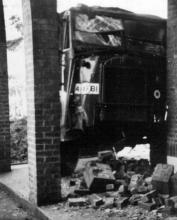In December 1938 I arrived in Hong Kong to join the floating staff of the China Navigation Co as Second Engineer Officer and was employed on the general China Coast trade going to Tientsin in the North and as far as Bangkok in the South. On the Northern runs we were frequently harassed by the Japanese Army and Navy for it must be remembered that there was a state of war between China and Japan since 1937. Due to this there was a shortage of rice in Shanghai and elsewhere so our ship the S S "Soochow" of 2,000 tons burden was engaged on a run to Rangoon for full cargoes of rice for the people of North China calling in at Singapore and Hong Kong for bunkers, water and general supplies.
So it was that we sailed into Hong Kong harbour at 6 AM on the morning of December 8, 1941 having obviously sailed through the Japanese fleet the previous evening without detection only to be told that England was at war with Japan and therefore we had to proceed to Holt's Wharf and unload our cargo. We had brought up from Singapore a new Colonial Secretary for Hong Kong whose name was Gimson and who had repeatedly told us that there would be no war in the Far East. The bombing of Kai Tak airport and other parts of Hong Kong at 7 AM that morning proved how wrong he was.

